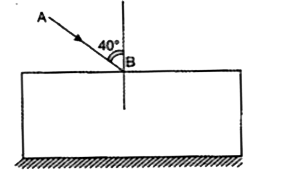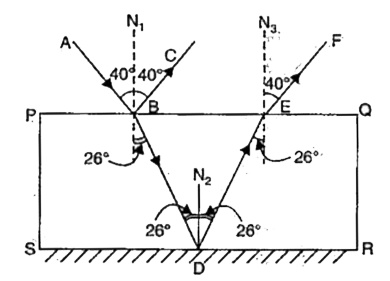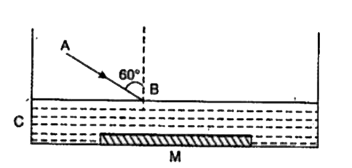The figure given below shows a solid glass block of refractive index 1.5. the lower surface of the block is silvered and behaves as a reflecting mirror. A white light ray AB incidents on the glass block at angle of incidence 40∘. Copy the diagram and trace the path of reflected and refracted rays from upper and lower surfaces of the block. (Take sin40∘=0.64andsin26∘=0.43)

The light ray incidents at glass surface at 40∘ By Snell.s law

n=sinisinr⇒1.5=sin40∘sinr
⇒sinr=sin40∘1.5=0.641.5=0.43
⇒r=26∘
When light ray AB strikes at point B on the surface PQ of the glass block, part of the light reflects as ray BC and part of the light refracts to medium glass at angle of refraction 26∘. the ray BD falls on the silvered surface RS and reflects as ray DE. The ray DE refracts again from the surface PQ and emerges as ray EF.
Similar Questions
Unpolarized light is incident on a plane glass surface. What should be the angle of incidence so that the reflected and refracted rays are perpendicular to eachother ?
View SolutionUnpolarized light is incident on a plane glass surface. What should be the angle of incidence so that the reflected and refracted rays are perpendicular to eachother ?
View Solution
Knowledge Check
- Question 1 - Select One
A ray of light incident on a transparent block at an angle of incident 60∘. If the refractive index of the block is 1.732, the angle of deviation of the refracted ray is
A15∘B25∘C30∘D45∘ - Question 2 - Select One
Unpolarized light is incident on a plane glass surface. The angle of incidence so that reflected and refracted rays and perpendicular to each other, then
Ataniβ=μ2Btaniβ=μCsiniβ=μDcosiβ=μ - Question 3 - Select One
Unpolarized light is incident on a plane glass surface. The angle of incidence so that reflected and refracted rays and perpendicular to each other, then
Ataniβ=μ2Btaniβ=μCsiniβ=μDcosiβ=μ
The figure given below shows a container C partially filled with water. There is a plane mirror M at the bottom of the container. A light ray AB incidents on the surface of water at angle of incidence 30∘. Copy and complete the ray diagram. Mark the ray emerging from the water surface. refractive index of water=43.
 View Solution
View SolutionA ray of light is incident on the surface of a glass plate of refractive index 1.6 at polarzing angle. Calculate the angles of reflection and refraction.
View SolutionA ray of light falls on a glass plate of refractive index μ=1.5.
What is the angle of incidence of the ray if the angle between the reflected and
refracted rays is 90∘?View SolutionA ray of light falls on a glass plate of refractive index μ=1.5.
What is the angle of incidence of the ray if the angle between the reflected and
refracted rays is 90∘?View SolutionA ray of light falls on a glass plate of refractive index μ=1.5.
What is the angle of incidence of the ray if the angle between the reflected and
refracted rays is 90∘?View Solution
